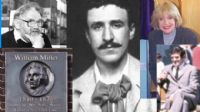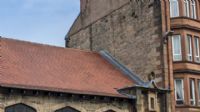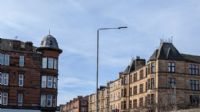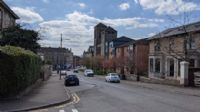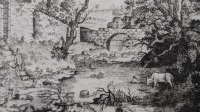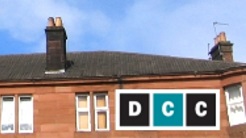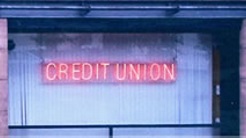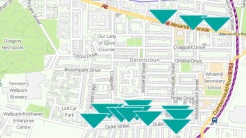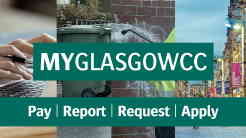Ian R Mitchell - Walking in Glasgows East End
Around Brigton Cross - Glasgow's Changing East-End
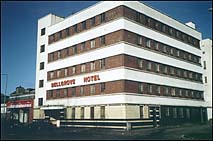
Where would you find a Venetian palace, a Byzantine mausoleum and the Shipka Pass? In the Balkan peninsula certainly, but if you didn't want to go so far from home you could just take a wee daunder for a mile or so instead around Bridgeton Cross in Glasgow's East End.
The experience of urban rambling is sadly underrated, and mainly limited to the obviously tourist cities. This was not always the case, and before 1950 exploration in our industrial cities was more widespread. In Glasgow for example there are many books from half a century ago and more, giving its inhabitants tips about and guides to places to walk; James Cowan's From Glasgow's Treasure Chest for example. With the Urban Renaissance going on around us in the increasingly post-industrial cities, especially Glasgow, it is high time to re-invent this tradition.
The territories to the east of Glasgow Cross might seems at first infertile regions with which to begin such a project. Certainly this is an area which has had a decidedly bad press, exceeded only possibly by that of the Gorbals. Those who know Glasgow from 'No Mean City' type hearsay will associate the East End with razor gangs, Billy Boy sectarianism, and some of the worst housing in Europe. My surnamesake James Leslie Mitchell (aka Lewis Grassic Gibbon) stated in the 1930s in The Scottish Scene that hereabouts "over a hundred and fifty thousand human beings living in such conditions as the most bitterly pressed primitive in Tierra del Feugo never envisaged." An exaggeration certainly, but containing a deal of truth. One thing that would astonish Gibbon is that today the population of Glasgow's East End area is probably not a quarter of the number he quoted. Several parliamentary constituencies -including Brigton itself which was the Red Clydesider Independent Labour Party rebel John Maxton's seat - have disappeared. And it was a protest at housing conditions as much, if not more, than industrial exploitation, which swept Maxwell to power in the 1920s. Maxton was not from Brigton, but he taught in Green Street school here and represented the area in Westmister from 1922 till his death in 1946. They used to say they weighed, not counted, his votes, and he was revered and loved by the local population.
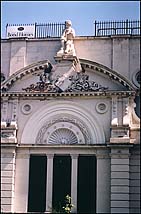
Around 1914 Glasgow had over a million people and was the Second City of the Empire; it was, as is less well known, the Sixth City in the whole of Europe in size. It produced three quarters of the Empire's ships, half its locomotives and huge amounts of other heavy industrial equipment. Since the 1960s Glasgow has haemorrhaged population; today there are about 625,000 inhabitants. In thirty years Glasgow has lost population at a rate of almost 10,000 a year. Put another way, that means that each decade since 1970 Glasgow lost more population that the entire Highlands during the whole century of Highland Clearances!
Nowhere have these effects of Glasgow's industrial decline been as visible as in the East End. Indeed, there started the ill fated Glasgow East Area Renewal (GEAR) project in the 1970s, where huge areas of substandard housing were cleared and attempts were made to attract new manufacturing industry to the area to replace the large works which had closed down or were in decline. These included Beardmore's Parkhead Forge which during the wars employed 20,000 men, the Arrol Bridge and Crane Works, Anderson Strathclyde mining machinery and many more proud names in Scottish industrial history. Half a billion pounds certainly cleared the slums, but the new industries didn't come - and the people left. It was Brigton No More! A recent OECD (Organisation for Economic Co-operation and Development) report on Glasgow said it was developing a two track economy; bands of remarkable regeneration and prosperity, alongside areas of continuing deprivation and exclusion; this certainly applies to the East End. Let's go Walkabout. Take the train to Brigton Station and emerge into the light at Brigton Cross.
At the Cross itself is one of Glasgow's best cast iron productions, the 50ft high Umbrella, complete with clock tower, originally built to shelter the unemployed in 1875. Unlike most public cast iron work in Glasgow it was not produced at the Saracen Foundry in Possil, but by the Sun Foundry. One has to look hard, I admit, for an urban renaissance in the immediate vicinity of the Cross, but there are things of interest. In Laudressy Street, next to the Public Library stood till the mid 1980s the Bridgeton Working Men's Club. Clubs like this one, founded in 1865, though latterly becoming mainly drinking quarters, initially provided places of entertainment and instruction for the working man before 1914. And in radical Brigton there was no more popular reading than the poems of Burns. The Bridgeton Burns Club, founded in 1870 became the largest in the world, with 1,400 members, and it sponsored competitions in local schools for the recitation and signing of the bards works.
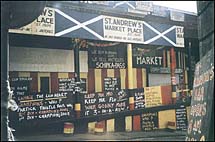
From the Cross a stroll along London Road and then up Fielden Street takes you past some of the less imaginative 1970s council housing, and some of the best of its more recent rivals at filling the vast waste sites in the area. Certainly it is a patchy picture, but Miles Better than the situation which appalled me on my arrival in Glasgow thirty years ago, well described by William Barr in Glasgwegiana (1973),
You are struck by the general scene of decay and neglect that pervades the area. Street after street of tall tenements stand empty, their shattered windows open and gaping to the sky. Broken glass lies in profusion on the streets and the unchecked running water floods into the street the engineering works, mills and factories have been closed down leaving Bridgeton with the appearance of a ghost town.
Turning back west along the Gallowgate you pass on one side St Mungo's Academy, recently renovated under the controversial Scools 2002 Private Public Partnership scheme, but balanced against that on the other side of the street is the fabulous Art Deco Bellgrove Hotel - now run-down and used as a Model Lodging House. Possibly not the best image to encourage young scholars to a life of study. Next along is the former meat and cattle market, one of Glasgow's many nineteenth century civic markets, whose façade has been lovingly retained though the market is no longer used. Aside from the astounding façade there are many things around here to interest. At the back end of Graham Square is the eighteenth century inn (now housing) where the cattle dealers and drovers would reside during sales, while outside shawlie-wifies would queue for pails of blood with which to make black puddings and combat anaemia in their weans. While much of the huge site of the market remains sadly derelict and littered, Graham Square hosts a development of housing association properties of the highest social and architectural merit, which won a Saltire Award in 2001
A walk up Bellgrove Street takes you to Duke Street. Turning west you soon pass below below the Necropolis. Though technically outwith Brigton. Glasgow's graveyard for its wealthy citizens is well worth a visit, especially now that it has been largely restored. Below it is found probably the only large scale factory left in this area; the Tennent's Brewery, which, ironically, must also be the oldest industrial undertaking in the city, dating from 1556. In the Necropolis are Gothic tombs and Byzantine mausoleums some of which are bigger than the average single-end that most people in and around Bridgeton once inhabited. But that there were better class tenements here is shown by the rosy sandstone survival on Hunter Street, opposite the Tennent's Brewery, a fine building with elaborate bas-reliefs of brewing trade (the tenement belonged to Tennents). It has to be admitted though, that not many of the buildings in this area were of this standard, and few of the nineteenth century tenements remain.
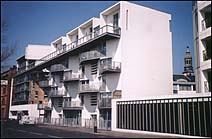
Heading south again by Barrack Street (so called because troops were stationed there in the early nineteenth century as a counter measure to local radicalism) takes you back to the Gallowgate and then past the Barrowland ballroom to the Barras, the world centre of reset goods, hucksters, conmen - and the odd bargain. In the most daring move yet, a former clay pipe factory and subsequent warehouse next the Barras is being coverted into flats for sale, in the middle price range, showing that regeneration is slowly reaching the obscurer corners of the city. However a few steps further towards Glasgow Cross and you are reminded this is Glasgow, not Hampstead. The curiously named Shipka Pass (after a battle in a forgotten Balkan war) hosts a market whose proprietor Mr. Barton clearly feels the Barras has sold out to Yuppiedom. Its signs display a weird mixture of erudition and self-revelling Glasgow grottiness. How much longer will this survive? Glasgow without such gallus cheek would not be the same.
Cross the London Road from Shipka Pass and you are heading for St Andrews Square, which could be the surprise of your day if you don't know the city. A recent housing development in traditional style flanks the St Andrews Church, one of the gems of Glasgow's ecclesiastic architecture, and now an Arts Centre and Restaurant. The Church, finished in 1757, was modelled on St Martin's in the Fields in London to a design by Dreghorn and boasts magnificent rococo plasterwork inside. Just south on the corner of Greendyke Street is the Kirk of St Andrews by the Green, known as the Whistlin Kirk or the Piskie Kirk, finished seven years earlier. Apparently the first Episcopalian place of worship to be built in the city after 1689, the mason who built it was excommunicated by the Glasgow Presbytery; the fact that the Kirk had an organ gave it its name. Again imaginative thinking has restored it as Housing Association offices, and the graveyards have also been renovated. The existence of such prestigious kirks here reminds us that, unlike other industrial areas of Glasgow like Govan or Springburn, the East End developed beside, and then overwhelmed, an area inhabited by the upper echelons of the Dear Green Place. The University itself backed onto this area, till its scholars fled to the West End in the 1870s.
The Whistlin Kirk(as well as a pub of that name!) faces Glasgow Green itself. Around the Green are social contradictions you would be hard to find in any other city; Glasgow grot cheek by jowl with futuristic urban renewal. A stone's throw from the Green is Paddy's Market where the poorest come and buy things most of us would be embarassed at throwing away; throw the stone the other way and we have the Homes for the Future, staggeringly effective models for urban living built for the Year of Architecture in 1999 - and snapped up despite the six-figure price tags, showing that many people want to live city centre. And why ever not? The view over the Green and the Clyde from these houses, to the Cathkin Braes in the far south, is worth a mortgage itself.
And seeking refreshments in this region is an adventure. There is the international fusion cuisine of the Café Source in St Andrews Kirk, or under the disused railway bridge by Paddy's is a devils kitchen Snack Bar serving ham ribs and cabbage to the market's shoppers and Salvation Army residents sheltering under the bridge. Where else can such a choice of eateries - with just about everything in between- be had in such a small area?
The Green is also a salutary reminder of many of the good things about the old East End, which should not be forgotten. It was here that the early trades unions held their demonstrations, from the striking Calton Weavers in 1787 to the UCS work-in in the 1970s, and where the suffragettes and temperance fighters staged their rallies. The Green was always a demotic place, the population originally having the right to dry their clothes and graze their animals on it, and later with the Glasgow Fair spilling onto the Green from the 1840s. Generations of tanner ba football enthusiasts honed their skills there. The Green was the first home of Rangers F.C., and even today Brigton and Rangers are held, shall we say, to have a certain special relationship. It is fitting that Glasgow's People's Palace, a museum to its rich working class life, is located there, and that a major renewal programme is preparing the Green for the new century, supported by Heritage Lottery and Scottish National Heritage funding. Central to this is the restoration of the Doulton Fountain from the Empire Exhibition of 1888, at present fenced off to prevent further vandalism. Described as "an exuberant terracotta wedding cake" it celebrates an Empire at its apogee; that a bolt of lightning shattered Victoria at its summit in 1894 was possibly a reminder that nothing lasts for ever.
Glasgow's East End has traditionally put its best face to the Green, with the now vanished Monteith Row being originally composed of grand town houses; these later were converted into slum warrens and are now all gone, apart from one building which house a Hotel, often, and in this case, a euphemism hereabouts for a Lodging House. Yet a few hundred yards away is the Inn on the Green, one of Glasgow's uppest-market eateries and hotels. Another prestige address was Charlotte Street, where town mansions housed entrepreneurs such as David Dale, one of the founders of Glasgow's cotton industry. His house, built in 1782, is the only one remaining, and has thankfully been saved by conversion into housing association dwellings- winning another Saltire Award in 1990. J.G. Lockhart, Walter Scott's son in law and biographer died in Charlotte Street, while James Stuart Blackie, the eminent Greek scholar, was born there. At the eastern end of the Green there is another example of this areas rich built legacy, one of the world's most amazing factories - Templeton's carpet factory, now, like so many of the industries of the past, closed. William Leiper's 1889 design, based on the Doge's Palace in Venice, and faced in polychrome brick overcame the initial resistance of the City Council to have a factory on the Green itself, and the Kooncil duly purchased its carpets from Templeton's for decades. What is less well known is that a fault in design led to the collapse of the façade killing 29 workers, and it had to be rebuilt. The factory has escaped demolition by being converted into offices and smaller workspaces, but employing many less than its former workforce.
A short distance east of Templeton's on McPhail Street is the former Greenview School, a splendid building , originally the mansion of the cotton baron, MacPhail, and dating from 1846. The philanthropist James Buchanan left £30,000 for its conversion into a school "for the maintenance and instruction of destitute children." The year after the Education Act of 1872, which made education compulsory, the delightful Young Scholar in studious pose, was carved in sandstone by William Brodie and placed atop the building. This, along with the adjacent Logan and Johnstone School of Domestic Economy, which a Beehive bas relief tells us was "Instituted in 1890", provided instruction for generations of Brigton bairns, but have long been surplus to requirements. They are in the process of being converted into flatted dwellings, to bring new life to old buildings, and help arrest the area's depopulation. A pleasant continuation to the Shawfield Bridge brings the Green to an end. Here at Flesher's Haugh can be found a headless statue of James Watt, whose epoch-making discoveries regarding the steam engine,came to him while walking hereabouts. It was his invention that allowed industry to move into towns from the water-powered countryside, and laid the basis for the industrialisation of Glasgow. Surely his headless torso is no fitting memorial? Or maybe, given de-industrialisation, it actually is.
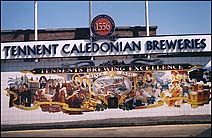
As one heads northwards to Brigeton Cross up Main Street, the adjoining Mill Street, Poplin Street and Muslin Street (and Dale Street) remind you that before heavy engineering this was cotton country, and hereabout lie the gaunt ruins of former mills, like the huge Carstairs Street Cotton Mill, awaiting a new use, or more likely demolition. The weaving period left its legacy of song. Many will have heard the words of the Calton Weaver which was written here; but not so many know that Alex Rodger, another weaver-poet, wrote The Muckin o Geordies Byre in Brigton. So the areas musical traditions are not only those of Billy-Boy doggerel. Around this area signs of regeneration are few, and we are definitely in the land of Dookits and back-alley Boxing Clubs. Soon we are back at the Cross where we started a couple of hours ago, and we have only scratched the surface of this fascinating area. I have not even mentioned (so will now) The Saracen Head Inn, built in 1754, where the old stagecoach used to depart for its 12 day journey to London, (or the Sarry Heid as it is locally known - even Sorry Heid - by hangover sufferers). Wordsworth and Burns - as well as Johnson and Boswell- visited here at the time when it was the rendezvous of the town's elite. A huge five-gallon punch bowl from the Sarry Heid, now in the People' s Palace, commemorates the drinking bouts of those days. The East End may never become a major tourist destination but in a couple of miles radius from Brigton Cross there is more to see and think on than in many more salubrious areas of Glasgow.
Being located so close to the city's thriving centre, with its expanding commercial activities and increased demand for housing, Brigton is better placed than many other post-industrial areas to benefit from Glasgow's re-invention of itself as a city of the future rather than the past. But real problems remain. The old Parkhead Forge will never return, and the new Forge shopping centre employs only a small percentage of its former workforce in largely unskilled low-paid jobs; the good jobs in the post industrial city are not ones for which Brigton's residents are qualified, And we cannot forget that Brigton lies within that Glasgow which is the cancer and heart attack capital of Europe. But walking around its streets, though it causes me occasional anger, does not cause me despair; I always return from Brigton uplifted. There is hope if the motto of the Bridegton Working Men's Club is followed:
Learn from the past / Use well the future
Ian R. Mitchell, 2002.
You can read more of Glasgow writer Ian Mitchell at
Getting to know Glasgow: walks, facts and historical developments.
